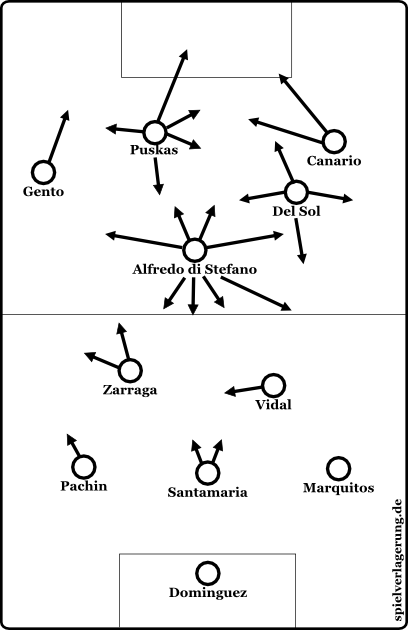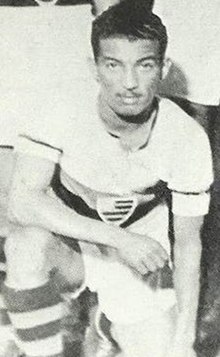The Italian journalist, Giordano Fatori, while covering the 1950 WC for the “Gazetta dello Sport” had occasion to write - “The football of Zizinho reminds me of Da Vinci painting something rare.”
Seeing as how Thomas Soares da Silva went from being called by the dimunitive "Zizinho," to the regal "Mestre Ziza" (Master Ziza) for his displays during the mid to late 1940s, it was a fitting description.
At 18 years of age, Zizinho’s life ambition was to play for America of Rio Janeiro. However, his frail physique turned off the club’s technical staff. Broken hearted, he then went to try out for Flamengo as a last resort. These amateur tests occurred against stars of the pro team. Early on the great Leonidas da Silva (no relation) picked-up an injury, and the coach Flavio Costa, called upon the teenager to replace him among the pros.
After an exhibition of football still commented upon today, Costa calmly advised him to, “Get a hair cut and come back tomorrow.” Thus began the career of one of the most technically gifted and refined players in Brasilian and world football.
At 19 he was absolute starter on a stellar Flamengo squad that included Domingos da Guia, Fausto and Leonidas. He pulled the strings on the legendary Carioca championship three-peat of 1942,43,44. He, along with those other craque black players, helped transform a formerly elitist club into one of the most popular in Brasil.
He left Flamengo ten years later, deeply hurt for having been traded without consultation. In between the 1949-1950, while widely recognized as the best player in the country, he found out that his pass had been sold to Bangu for a sum then considered a small fortune. In a sign of different times, it is said that he signed his Bangu contract without reading it, stating to the club president, “If you, Sir, paid such a sum for my pass, it must be because you appreciate my game.” In the first game aginst his old team, he exerted his revenge, imposing the most lopsided loss in Flamengo’s history (0-6).
Seven years later, at the age of 37, he moved to Paulista championsip to play for FC Sao Paulo, where he also became an idol, helping to winning the championhip in his last year.
Curiously, after three years retired from the game, he was asked to play one game with Audax Italiano of Chile by admirers in team management. He accepted the gracious invite, but instead of one game, played the whole season. His last as player.
Selecao
Zizinho was the star of the Selecao during the decade of the 1940s. He played a total of 53 games, scoring 30 goals. He won the Copa Americal / sul-americano of 1949 and was was universally acclaimed as the best player of the 1950 WC, despite the loss to Uruguay in the final game.
Willy Meisl of London’s “World Sports” wrote the following after the Spain game in WC 1950. “We are not talking simply of a great player, one of the many great players found in diverse parts of the world. This is a genius. A man who possesses all the qualities that could be wished for by a professional in order to approximate perfection.”
The Spanish referee Pedro Escartin in a book about the 1950 WC (title “"Lo de Brasil fué así...".) captioned Zizinho's photo simply, “Zizinho ou A Arte [Zizinho or The Art].”
After that 1950 loss Zizinho was so depressed that he thought of abandoning football. But he later admits that it was only by continuing to exhibit his skills on the pitch that he was able to “free” himself from that letdown. As he once said, “It is absurd the attempts made to place the blame for that defeat on some of my teammates, as they did with Barbosa. No one should ever be condemned individually for that game.”
In 1954, despite the whole country wanting him to be part of the Selecao, the coach, Zeze Moreira left him off the team. This caused a national debate. Could it be that Zeze only wished to have one man pulling the strings (Didi)? The reasons to this day are not clear, though Zizinho himself felt that he was blackballed by the writer Jose Lins do Rego, who was the head of the Brasilian delegation of the 1953 Sul-Americano in Peru, and one of the technical directors in the 1954 selections.
Zinzinho. “I returned to the Selecao in 1953 [after the 1950 loss], but had some issues with the head of the Brasilian delegation at the Sul-Americano [Copa America predecessor], the writer Jose Lins do Rego. First, the players asked me to speak with him because the quotas ($) were half of what they were the previous year. Afterwards, since I was injured, he wanted me to take an injection to play the final. I would never do this. I often played hurt, but never took injections. When Brasil lost, he wrote in his column in the journal “O Cruzeiro” that we players were mercenaries and fainthearted. I had a weekly column in “Diario da Noite” and responded by saying that I knew quite a bit about the inner workings of the selecao.”
Could it be that thanks to politics – always present in human endeavours - European audiences were thus deprived of seeing Zizinho face the Mighty Magyars?
As for 1958, he was then 37 years old, playing his last football in Brasil. He was selected 4 days before the Selecao embarked for Sweden. “I couldn’t accept. I wasn’t a youngster anymore. It would not have been right with the players already training. I’m just sad that I never realized my wish to play alongside Pele”, Zizinho commented in an interview in 2000.
Idol
Distefano was in awe of Pedernera, Maradona looked-up to Rivelino, Cryuff emulated DiStefano, and Pele and Didi both idolized Master Ziza. In Zizinho, Pele saw the mirror image of what he wanted to become, a complete footballer.
In Pele’s words when asked about his idol during his playing days with Santos, “Zizinho was the complete article. Played as well in the midfield as he did in the attack. He was offensive, and new how to mark. He wasn’t afraid to get ugly either [reference to the often physical and intimidating nature of games at the time].”
Indeed history records that Zizinho dribbled like few others, created like even fewer, and was the complete footballer.


